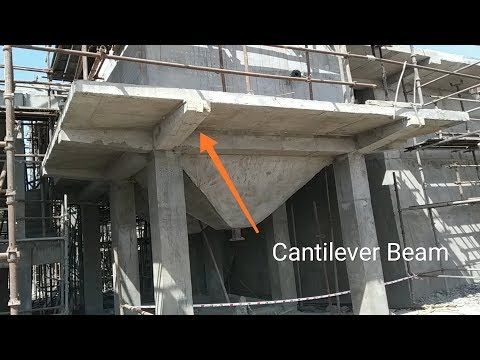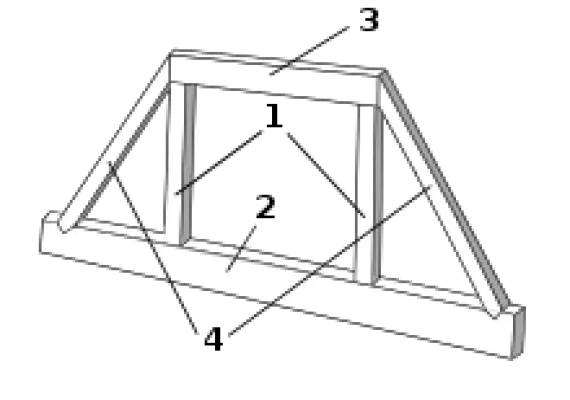What is a Cantilever / Cantilever Beam? | Example of Cantilever Beam | Cantilever Beams Deflections
What is a Cantilever and Cantilever Beam? | Example of Cantilever Beam | Advantages and Disadvantages of Cantilever Beam | Cantilever Beam Details | Cantilever Beam Uses
What is Cantilever?
A cantilever can be defined as a projecting member or beam supported at only one end and carries a load at only one end or distributed along the unsupported portion. The upper half of the cantilever beam’s thickness is subjected to tensile stress, tending to elongate the fibers, the lower half to compressive stress, tending to crush them.
It is the rigid structural member/element projecting from a vertical supporting member, especially when the projection is excellent with the depth. The upper part of the structure is in tension and the lower part in compression.
A cantilever is a rigid structural member extending horizontally and is supported at only on one end. Generally, it extends from a flat vertical surface such as a wall, to which it must be firmly attached. Like other structural members, a cantilever beam can be formed as a beam, plate, truss, or slab.
When the beam is subjected to a structural weight at its far, unsupported end, the member carries the load or weight to the support where it applies shear stress and a bending moment. It allows overhanging structures without additional support.
What is a Cantilever Beam?
A cantilever beam is a structural element that resists bending. A cantilever beam is a beam that has only one end supported. Cantilever beam means if one end or one point of the beam element is supported, the endpoint or the endpoint continuing over the support and the endpoint is not held by any support; that is, such beams are called cantilever beams.
It is a horizontal beam with only one end resting on the support and the other end in space. The loads on such a beam create tensile stress on the upper side and compressive stresses on the lower side. Cantilever beams are widely used in both buildings and machinery.
Any beam that comes out of a wall in the building and whose end is free is considered a cantilever beam. These carry structural elements such as roofs, eaves, and galleries, which are desired to be free.
Cantilever Beam Uses
A cantilever beam is a structural element that is used in engineering for a variety of purposes, such as bridges, cranes, and other large structures.
Forming an overhanging section of a building without the expense of additional supports is often a use for a cantilever beam.
A cantilever beam is a structural element that supports loads, spanning between two points. The load bearing capability of the beam depends on the type of material and its dimensions.
A cantilever beam can be used to support any type of load like gravity or lateral forces.
Cantilever Beams Deflections
Deflection in engineering is the extent a structural element shifts when subjected to a load (due to its deformation). It could be an angle or a distance.
The deflection distance of a member under load can be estimated by integrating the function that mathematically characterizes the slope of the member’s deflected shape under that load.
For the deflection of typical beam configurations and load instances at discrete sites, standard formulas exist.
Methods such as virtual work, direct integration, Castigliano’s method, Macaulay’s method, and direct stiffness are employed instead.
Beam element deflection is often computed using the Euler–Bernoulli beam equation, whereas plate or shell element deflection is calculated using plate or shell theory.
Building construction is one example of how deflection is used in this context. Materials for varied uses are chosen by architects and engineers.
Because cantilever beams have one fixed end, the slope and deflection at that end must be zero.
Cantilever beams are beams that are restricted by only one support, as shown in the above illustration. Because they are only supported at one end, these members would naturally deflect more.
To compute the cantilever beam’s deflection, use the equation below, where W is the force at the endpoint, L is the length of the cantilever beam, E = Young’s Modulus, and I = Moment of Inertia.
The amount of beam deflection is normally determined by four major variables. These are some examples:
- How much weight is on the structure?
- The unsupported member’s length
- The substance, specifically the Young’s Modulus
- The cross-sectional area, and more specifically the moment of inertia (I)
Example of Cantilever Beam
Real-life applications of cantilever beams can be exemplified by stadiums, porches, gas station canopies (roof-type low-slope structure that covers the areas where the pumps are located at gas stations). Cantilever beams are also used in bridges where large spans and heavy loads are involved.
Cantilever beams are permitted under minimal conditions in reinforced concrete structures, but these limits can be exceeded much more in steel structures than reinforced concrete. For example, cantilever beams reaching 2 meters in reinforced concrete structures are rare but cantilevers up to 5 meters in steel structures and 10 meters according to the application can be made.
The most typical example of this is Forth Bridge in Scotland. Three gigantic pillars were used in the bridge, each consisting of two cantilever beams. There are also cranes operating on the cantilever beam principle installed to serve large areas such as construction sites or shipyards.
The relatively light ones of these are located on a mobile tower. The heavier loads are attached to a fixed building. A rotating pivot that descends to the ground causes the crane to rotate around itself.
Examples of Cantilever Beam Design
Advantages and Disadvantages of Cantilever Beam
Advantages Of Cantilever Beam
- Cantilever beams are economical.
- They are lightweight and easy to install.
- Cantilever beams can be used in a variety of shaped structures including curved shapes, which means they can be used in ships, bridges, and sometimes other types of structures as well. Some buildings, such as the Leaning Tower of Pisa, have been designed with cantilever beams because they are less expensive than other structural support systems.
- Cantilever beams can be used in many locations where other types of structural support are not allowed, such as in a ship’s hull.
Disadvantages Of Cantilever Beam:
- Cantilever beams cannot support axial loads. In addition, a cantilever beam cannot withstand the additional weight and stress that occurs when it is used for its intended purpose.
- The cantilever beam must have enough strength to support itself before anything else can be supported by it.
- Large deflections restrict the size of a cantilever beam.
Cantilever Beam FAQs
1. What type of beam is a cantilever beam?
A cantilever beam is a structural element that supports loads with only one end supported. A cantilever beam can be used to support anything, like gravity or lateral forces.
2. What is a cantilever beam used for?
A cantilever beam is a structural element that is used in engineering for a variety of purposes, such as bridges, cranes, and other large structures.
3. How does a cantilever beam support load?
The load bearing capability of the beam depends on the type of material and its dimensions.
4. What is a cantilever beam made of?
A cantilever beam is made of any material that allows it to support loads in a supporting application. That includes concrete, steel, and wood.
5. What is a cantilever beam used for in buildings?
A cantilever beam is often used to support an overhanging section of a building without the expense of additional supports.
6. What are the advantages of using a cantilever beam?
A cantilever beam can be used to support any type of load like gravity or lateral forces. It can also be formed into an overhanging section of a building without the expense of additional supports.
7. How does the deflection of a cantilever beam change as it supports an increase in load?
As the load on a cantilever beam increases, it will deflect more and more until it reaches the tipping load.
8. What is the maximum length of cantilever slab?
Conclusion on Cantilever Beam
Cantilever beams are often advantageous to use when the continuity condition is met. Especially if cantilever beams coming out of a person supported from two points have the ideal length, they will decrease the maximum moment value of the main beam and its moment; the value will give reasonable results.
While making cantilever beam calculations, attention should be paid to the length value, and very long cantilever designs should not be made unless necessary. Of course, as in every situation, long consoles have a solution with the right calculation.


